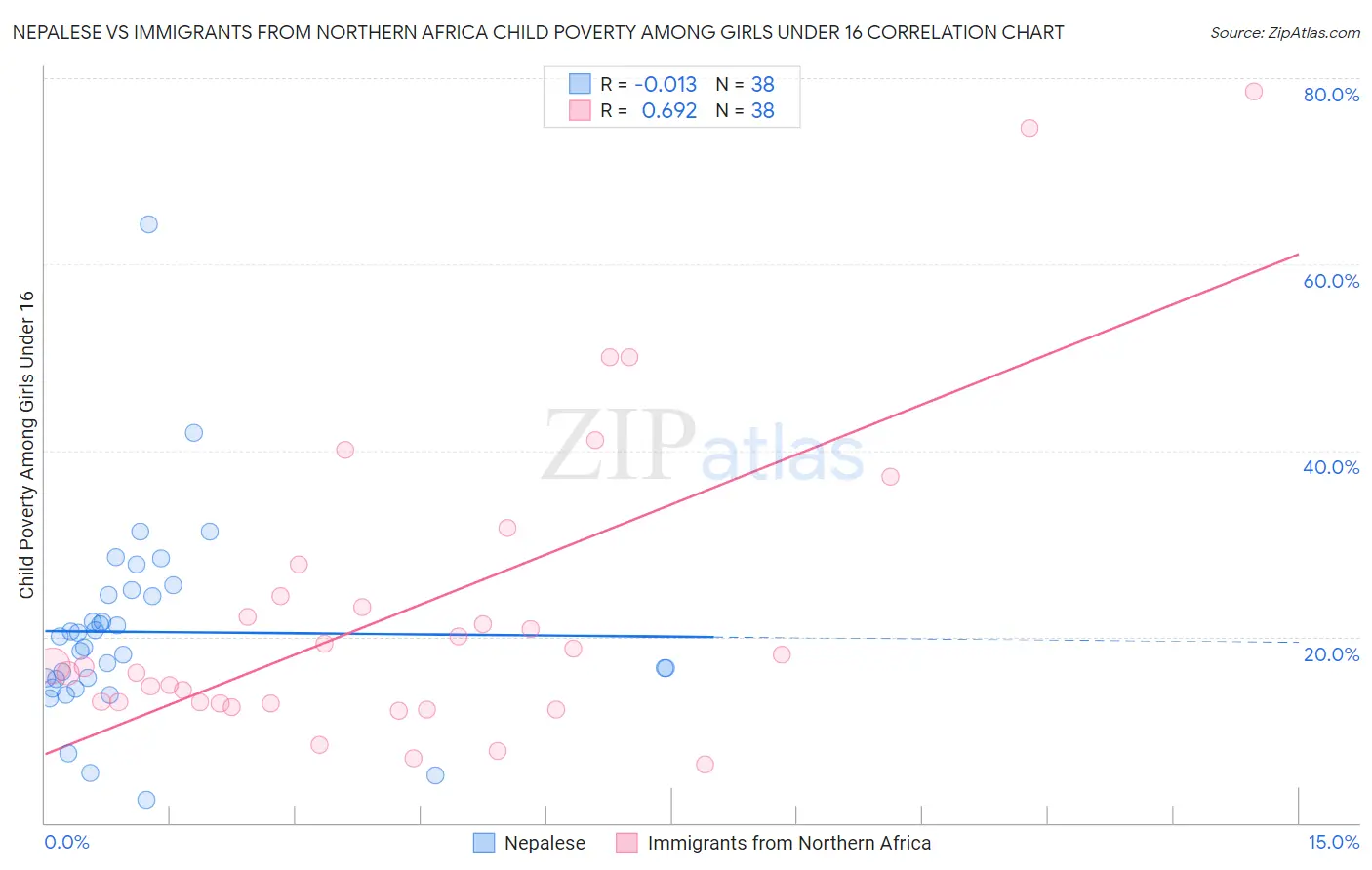Nepalese vs Immigrants from Northern Africa Child Poverty Among Girls Under 16
COMPARE
Nepalese
Immigrants from Northern Africa
Child Poverty Among Girls Under 16
Child Poverty Among Girls Under 16 Comparison
Nepalese
Immigrants from Northern Africa
18.6%
CHILD POVERTY AMONG GIRLS UNDER 16
1.1/ 100
METRIC RATING
235th/ 347
METRIC RANK
16.0%
CHILD POVERTY AMONG GIRLS UNDER 16
72.0/ 100
METRIC RATING
161st/ 347
METRIC RANK
Nepalese vs Immigrants from Northern Africa Child Poverty Among Girls Under 16 Correlation Chart
The statistical analysis conducted on geographies consisting of 24,511,115 people shows no correlation between the proportion of Nepalese and poverty level among girls under the age of 16 in the United States with a correlation coefficient (R) of -0.013 and weighted average of 18.6%. Similarly, the statistical analysis conducted on geographies consisting of 316,657,809 people shows a significant positive correlation between the proportion of Immigrants from Northern Africa and poverty level among girls under the age of 16 in the United States with a correlation coefficient (R) of 0.692 and weighted average of 16.0%, a difference of 16.2%.

Child Poverty Among Girls Under 16 Correlation Summary
| Measurement | Nepalese | Immigrants from Northern Africa |
| Minimum | 2.5% | 6.2% |
| Maximum | 64.2% | 78.6% |
| Range | 61.7% | 72.3% |
| Mean | 20.5% | 22.9% |
| Median | 19.5% | 16.8% |
| Interquartile 25% (IQ1) | 15.4% | 12.8% |
| Interquartile 75% (IQ3) | 24.5% | 24.4% |
| Interquartile Range (IQR) | 9.1% | 11.6% |
| Standard Deviation (Sample) | 10.6% | 16.9% |
| Standard Deviation (Population) | 10.5% | 16.7% |
Similar Demographics by Child Poverty Among Girls Under 16
Demographics Similar to Nepalese by Child Poverty Among Girls Under 16
In terms of child poverty among girls under 16, the demographic groups most similar to Nepalese are Alsatian (18.6%, a difference of 0.010%), Fijian (18.6%, a difference of 0.050%), Sudanese (18.6%, a difference of 0.12%), Immigrants from Nigeria (18.6%, a difference of 0.14%), and Immigrants from Sudan (18.6%, a difference of 0.16%).
| Demographics | Rating | Rank | Child Poverty Among Girls Under 16 |
| Alaskan Athabascans | 2.0 /100 | #228 | Tragic 18.3% |
| Ghanaians | 1.4 /100 | #229 | Tragic 18.5% |
| Osage | 1.3 /100 | #230 | Tragic 18.5% |
| Cree | 1.3 /100 | #231 | Tragic 18.5% |
| Immigrants | Sudan | 1.1 /100 | #232 | Tragic 18.6% |
| Sudanese | 1.1 /100 | #233 | Tragic 18.6% |
| Fijians | 1.1 /100 | #234 | Tragic 18.6% |
| Nepalese | 1.1 /100 | #235 | Tragic 18.6% |
| Alsatians | 1.1 /100 | #236 | Tragic 18.6% |
| Immigrants | Nigeria | 1.0 /100 | #237 | Tragic 18.6% |
| Immigrants | Eritrea | 1.0 /100 | #238 | Tragic 18.7% |
| Marshallese | 0.9 /100 | #239 | Tragic 18.7% |
| Nigerians | 0.9 /100 | #240 | Tragic 18.7% |
| Americans | 0.8 /100 | #241 | Tragic 18.8% |
| Immigrants | Cuba | 0.7 /100 | #242 | Tragic 18.8% |
Demographics Similar to Immigrants from Northern Africa by Child Poverty Among Girls Under 16
In terms of child poverty among girls under 16, the demographic groups most similar to Immigrants from Northern Africa are French (16.0%, a difference of 0.11%), French Canadian (16.1%, a difference of 0.47%), Slovak (15.9%, a difference of 0.49%), Guamanian/Chamorro (15.9%, a difference of 0.50%), and Immigrants from Oceania (16.1%, a difference of 0.52%).
| Demographics | Rating | Rank | Child Poverty Among Girls Under 16 |
| Immigrants | Chile | 76.7 /100 | #154 | Good 15.9% |
| Syrians | 76.7 /100 | #155 | Good 15.9% |
| Immigrants | Fiji | 76.1 /100 | #156 | Good 15.9% |
| Colombians | 76.1 /100 | #157 | Good 15.9% |
| Guamanians/Chamorros | 75.3 /100 | #158 | Good 15.9% |
| Slovaks | 75.2 /100 | #159 | Good 15.9% |
| French | 72.8 /100 | #160 | Good 16.0% |
| Immigrants | Northern Africa | 72.0 /100 | #161 | Good 16.0% |
| French Canadians | 68.7 /100 | #162 | Good 16.1% |
| Immigrants | Oceania | 68.4 /100 | #163 | Good 16.1% |
| Immigrants | Colombia | 67.8 /100 | #164 | Good 16.1% |
| Immigrants | Germany | 67.3 /100 | #165 | Good 16.1% |
| South Americans | 67.2 /100 | #166 | Good 16.1% |
| Uruguayans | 64.7 /100 | #167 | Good 16.2% |
| Yugoslavians | 64.4 /100 | #168 | Good 16.2% |